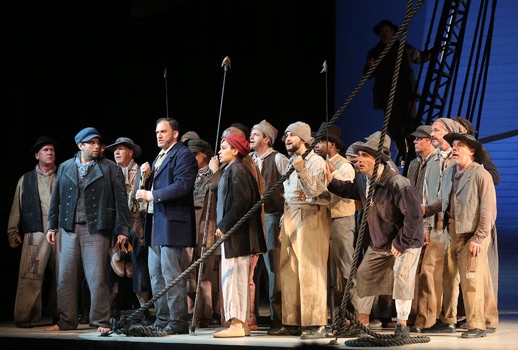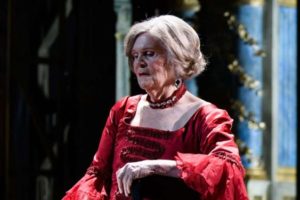

Also, like the elusive beast of its title, this work has resisted adaptation by some of our greatest film makers and theatrical wizards and its characters have completely confounded some of our most gifted thespians.
When Composer Jake Heggie was approached for a commission for the opening of the new Dallas Opera house in 2010 his favored collaborateur at the time, playwright Terrence McNally, sold him on turning the Melville into a grand opera played solely at sea with Captain Ahab cast as Heldentenor and Pip, his cabin-boy, as a pants role. Mr. McNally later had to withdraw due to illness from the project.
Mr. Heggie was then doubly blessed that his replacement, the highly skilled Gene Scheer managed to fashion a cohesive and eminently poetic narrative using only Melville’s language. Grubstaked by the opera companies of Dallas, State Opera of South Australia, Calgary, San Diego and San Francisco, the Pequod has since made port at Washington National Opera and is currently moored here at the Music Center for L.A. Opera.
Our Music Director James Conlon always gives a scholarly and impassioned pre-game talk about the work he’s about to conduct and this was no exception. It included a fiery defense of Mr. Heggie’s music from those critics who use the words “accessible” and “derivative” against him in a derogatory and contemptuous fashion. Mr. Conlon went so far as to ask the sizeable lecture audience if the person present who had invented the wheel would please stand. Citing the history of musical language and how it has been reshaped by the great musical minds of each era he went further to say the he rejects labels of orthodoxy and “schools” of music, instead judging compositions on whether they succeed on their own principles and merits.
I believe that Mr. Heggie does indeed speak with his own musical language. His prolific output of art songs alone has been a great boon to recitalists of all vocal types. He proves himself an exceptionally skilled musical architect in the building of ensembles and the interweaving of identifiable, character established, phrases. He’s also an extraordinarily articulate orchestrator. He does lack a modicum of authority at times in displaying to the audience a definitive conclusion to a current musical section.
The rousing Act I ensemble “Death to Moby-Dick” so moved quite a few audience members that they broke into applause at what they thought was its finale. Others, not so sure, waited for a good hearty whack at the end to show their appreciation which eventually didn’t come. The result could only be described as a golf clap. A similar problem marred the opening duet of Act II between Greenhorn and Queequeg and the two major set-piece arias for Ahab and Starbuck.

Chorus Director Grant Gershon deserved the bow he took at the end of the evening. The 30 men of the LA Opera Chorus made a mighty sound and were especially clear at more subtle dynamics like the elegiac scene in Act I,”Lost in the heart of the sea,” after the first hunt.
The star of the evening was undoubtedly the Starbuck of Morgan Smith whose association with this piece goes all the way back to opening night at Dallas and he was featured on the PBS telecast from the San Francisco Opera. In the flesh he was far more impressive, displaying a virile and sizeable baritone that easily carried over Heggie’s sometimes clamorous orchestra. He was a tower of strength at climaxes and made his gentle but fervent pleas to Ahab highly sympathetic as the sole voice of reason on board the Pequod.
Captain Ahab is in reality a bit of a one note role and was written for the great Ben Heppner who sang the premieres both in Dallas and Calgary. Jay Hunter Morris led the Australian production and then stepped into the San Diego performances when Heppner was indisposed. He has carried on with it since and it is a monstrous portrayal full of dichotomies of emotion and a wide range of vocal choices. Luckily he conjures the kind of presence that fills a theater.
I did find him declaiming more often than actually singing, though I suppose it’s the way the part is written. His greatest moments where his ice-cold refusal to the Captain of the Rachel for assistance finding his son lost at sea and the melting duet with Starbuck of reminiscence, “Ah Starbuck, it is a mild, mild wind,” that humanizes him briefly just before the sighting of the white whale.
It also deserves mention that among a cast with uniformly excellent diction you could have taken dictation from Mr. Morris, his words were so sharp and clear. He also spoke the 19th century idioms with a believable ease.

Jacqueline Echols as the cabin boy Pip has the distinct challenge of being the only soprano onstage with a crew of men. She did yeoman’s work with her bright voice in the ensembles keeping up the soprano end against a cast burly baritones and basses. The characters eventual madness wasn’t delineated enough however and her swim across the stage on a wire after she was lost at sea brought an uncomfortable titter from the audience.
A very able-bodied supporting cast included the standouts of tenor Matthew O’Neil as a characterful and scurvy-ish Flask, baritone Malcolm McKenzie as a lusty and ringing Stubb and Babatunde Akimboboye as the harpooner Daggoo, whose bass strengthened all the ensembles and was particularly good in the fight scene.
The original Dallas production designed by Robert Brill is heavily enhanced by the work of projection designer Elaine J. McCarthy, so much so that one crotchety critic along the way opined that the performance belongs more to the cineplex than the operatic stage. I can say the various representations of clouds and water are so intentionally blunt and limited in their realism that they could only be termed “theatrical.” Gavin Swift handled the skillful lighting following the original plots of Donald Holder in Dallas. Jane Greenwood’s costumes while certainly appropriate but all seemed a mite too new especially after what was supposed to be months at sea.
Director Leonard Foglia’s Broadway birthright shines through in both his pacing and in the almost too clever ways he uses a cinematic meld between scenes. Frankly, the production itself plays more like a Broadway show than an opera because of his deft touch.
Any work trying to distill seven hundred pages of the densest prose known to man is bound to come off as a bit glib. Yet the ending, and here my admiration for Mr. Scheer’s work cannot be greater, with its brilliant homage of literary reference, brought the kind of keen satisfaction that one rarely gets from an operatic/theatrical experience.
Photos: Craig T. Mathew/Los Angeles Opera
























Comments